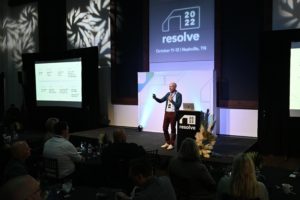In just the last year, contact center leaders have faced mounting pressure from a tightening labor market, a slowing economy, and unprecedented customer demand.
These changes have created a cycle of unpredictable call volumes and unsustainable wait times. They have also pushed contact center leaders to think differently when it comes to the future of customer service. They’re thinking bigger.
At Resolve 2022, CX leaders and innovators from a wide range of industries joined Replicant in Nashville to explore how automation can be leveraged to create a better, more efficient contact center.
From successful Contact Center Automation deployments at some of the world’s most trusted brands, to strategies for managing change across your organization, here are the top 10 takeaways from the conference.
1. Automation solves immediate problems
The 2022 Benchmark Report found that most contact center leaders (95%) have either already adopted, are implementing now, or are planning to implement automation within the next year. Resolve reinforced that trend with story after story from CX leaders inundated by unpredictable call spikes without possessing the necessary headcount to field each request. With agents hard to come by and demand hard to plan for, Contact Center Automation is an ideal solution due to its ability to fully resolve common issues – not just route or deflect them like previous solutions.
2. The future of contact centers is hybrid
Contact Center Automation places an emphasis on a multi-pronged approach to customer service – one where humans and machines work in tandem to assist customers. A hallmark of this model is the division of request types. Automation provides end-to-end support for common, high-volume requests that are prone to spikes and allows humans to be more available for urgent or complex requests that require human creativity.
3. Analytics drive customer experience
Contact center leaders are looking for solutions that don’t just relieve agents of demand, but also help them better understand their customers’ preferences. For example, an automation solution with rich insights and transcription can not just increase resolutions, but also help leaders find better ways to design conversations and respond to different kinds of unstructured speech.
4. Component-driven design makes AI easier
A key part of the discussion around today’s unpredictable contact center climate was the need for fast, frictionless automation projects. That’s why Replicant rolled out a roadmap of additional automation flows built on deployment-ready components. These flows make it easier than ever to achieve a live solution, while making integrations and continuous learning a breeze.
5. “Conversation Design” is top-of-mind
Conversation design plays a huge role in how effective an automation flow is. Resolve highlighted many of the best practices that contribute to a delightful conversation. For example, the ability to offer an eye exam when a customer cites blurry vision, or the ability to infer that a customer needs to make a policy change when they state they have a new car.
READ: 9 Tips to Design Automated Conversations That Actually Work
6. Leaders are focusing on change management
In a panel led by AAA and Canadian Auto Association, the importance of change management was stressed as a key driver behind the value they gained from Replicant. At both insurers, a strong collaboration between operational teams and frontline associates helped their agents understand the benefits of automation, while providing better experiences for members with every call.
“It’s not about replacing our team members’ jobs, it’s allowing them to use their analytical skills to the best of their abilities and automating some of the mundane tasks.” Lisa Rivier, Senior Director of Operations, AAA
7. Start-and-scale is a preferred strategy
When leading financial services company ECSI began using Replicant to automate customer interactions, they didn’t try to boil the ocean. Like many innovative brands, they started small. Every contact center has a handful of straightforward call types that eat up large volumes of agent time. Starting with just one use case allows leaders to realize value faster and scale to more flow types based on data and need.
8. Deflection is a poor outcome
Attendees from every industry were no longer interested in automated solutions that ultimately deflect the majority of callers to areas of self-service like apps or websites. In fact, they’ve found these types of solutions merely lower handle times by creating frustrated customers who feel as though their time was wasted with an ineffective call tree. Instead, first contact resolution (FCR) is a more important outcome for leaders seeking transformative automation solutions.
9. The “happy path” is only the beginning
Many contact center leaders have been a part of build-it-yourself automation projects. But a common roadblock they’ve faced is that the ideal conversation flow is usually not the most frequent result. In other words, effective automation requires AI with continuous improvement so that it can learn from every call automatically and be prepared for more diverse patterns of speech (one of the reasons Replicant comes pre-trained on millions of calls so you don’t need to wait years to achieve optimum results).
10. Containment isn’t everything
Just as deflection can have a negative effect on customer satisfaction, containment is no longer a leading indicator of good CX. Instead, leaders are choosing automation solutions that don’t trap customers in an automation loop. Customers who need an agent should get transferred to one as efficiently as possible, and Contact Center Automation is able to gather initial information and pass complex requests to agents with full context so customers don’t have to repeat themselves.







